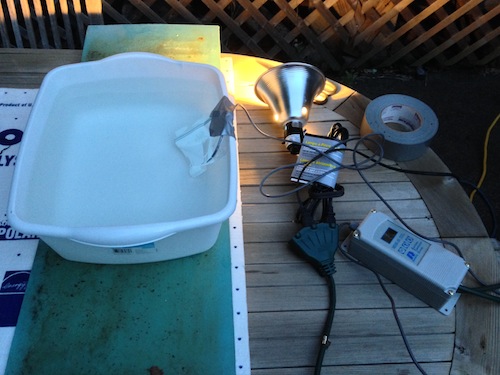Probably most of us have had the experience of staying in a bath too long, so that the water cools too much and stops being comfortable. A float tank is essentially an oversized bath, and we want to be able to stay in for hours without ever losing that Goldilocks neither-hot-nor-cool temperature. So we need a heating system.

When I acquired my float tank, it wasn’t so much a functioning system as a collection of parts, and most seriously, the thermostat was missing. I’ve acquired a replacement and was testing it out last night — thought you all might be interested.
What we have in the picture here in the gray box is an Electronic Temperature Control unit (that is, an industrial thermostat) wired up as a switch on the green extension cord. Plugged in to the cord is a lamp (so I can see whether power is on or off) and that blue-green rubberized board, which is a waterbed heater. The waterbed heater is sitting on a piece of styrofoam to insulate it a little from below, and resting on top of that is a washbasin. The thermal probe from the ETC is wrapped in plastic and duct-taped to float in the water. In our scene, the washbasin plays the part of a very small float tank.
For the engineering-minded, the specs are a little bit interesting — first off, that grey enclosure is rated “NEMA 4X”, which is to say, watertight, weatherproof, and corrosion-resistant, since it needs to work in the presence of salt water. (NEMA is an electrical industry standard, and 4X requires that it “must exclude at least 65 GPM of water from 1-in. nozzle delivered from a distance not less than 10 ft for 5 min. Used outdoors on ship docks, in dairies, and in breweries.” I think that’s firehose quantities: probably overkill, but it’s better not to mess around. And also, I couldn’t find a 3X model in any case.)
Second we need an ETC with as small a differential as possible. No thermostat can keep a single exact temperature. Instead they have a range: turn the heater on if the temperature is lower than T1, and turn it off once it’s higher than T2. The difference is called the differential, and this unit lets me set the differential down to 1°F.
When everything is set up, we will then be able to keep the tank water at a perfect 93–94°F, for your floating comfort.